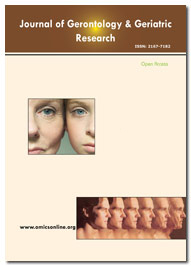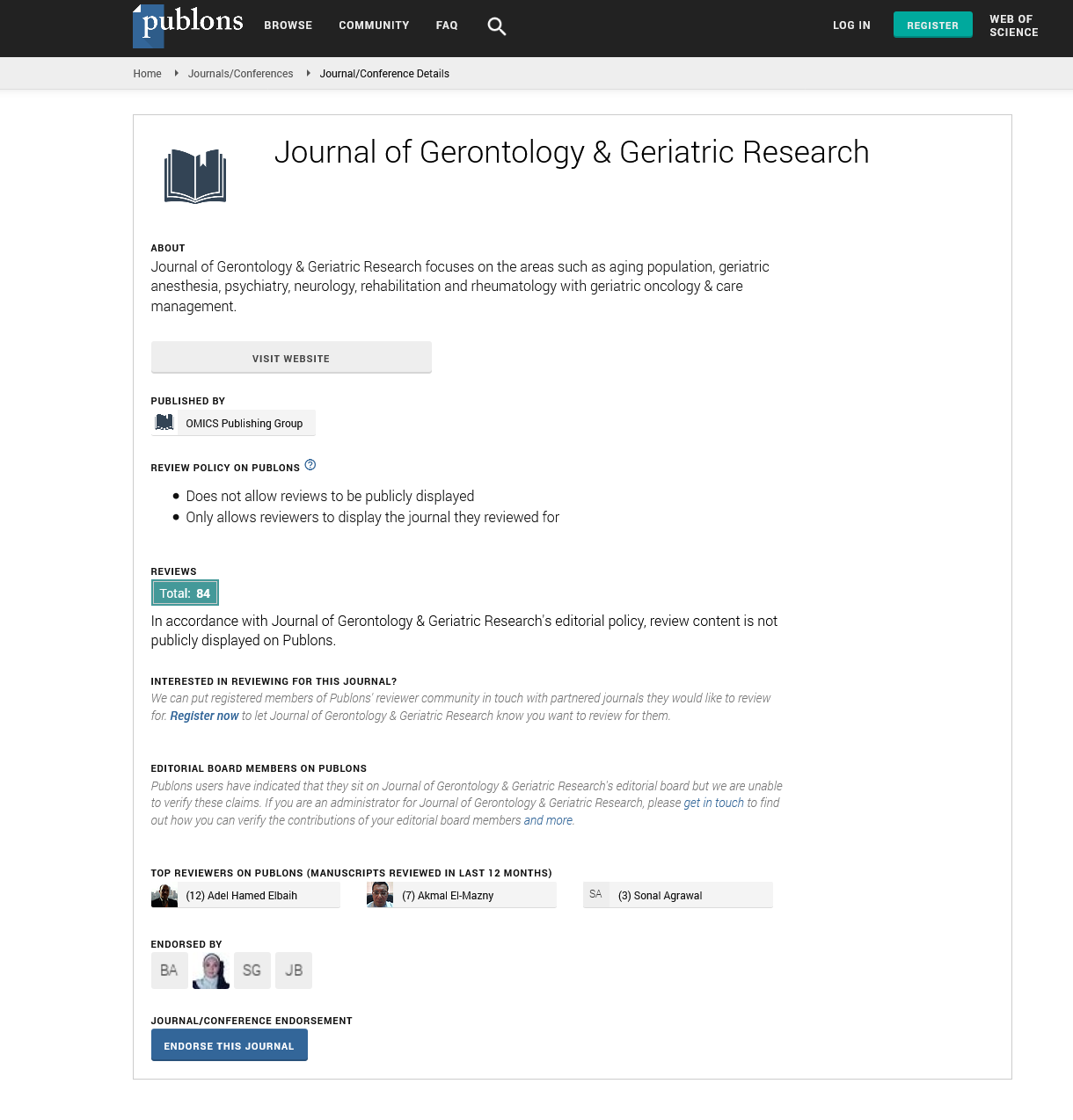Indexed In
- Open J Gate
- Genamics JournalSeek
- SafetyLit
- RefSeek
- Hamdard University
- EBSCO A-Z
- OCLC- WorldCat
- Publons
- Geneva Foundation for Medical Education and Research
- Euro Pub
- Google Scholar
Useful Links
Share This Page
Journal Flyer

Open Access Journals
- Agri and Aquaculture
- Biochemistry
- Bioinformatics & Systems Biology
- Business & Management
- Chemistry
- Clinical Sciences
- Engineering
- Food & Nutrition
- General Science
- Genetics & Molecular Biology
- Immunology & Microbiology
- Medical Sciences
- Neuroscience & Psychology
- Nursing & Health Care
- Pharmaceutical Sciences
Perspective - (2024) Volume 13, Issue 2
The Role of Nutrition in Mitigating Sarcopenia among the Elderly: A Meta-Analysis
Whynne Albetirle*Received: 01-Apr-2024, Manuscript No. jggr-24-25825; Editor assigned: 02-Apr-2024, Pre QC No. P-25825; Reviewed: 16-Apr-2024, QC No. Q-25825; Revised: 22-Apr-2024, Manuscript No. R-25825; Published: 30-Apr-2024, DOI: 10.35248/2167-7182.2024.13.722
Introduction
This article reviews the effectiveness of different nutritional interventions in reducing frailty among the elderly. It encompasses data from multiple clinical trials focusing on protein supplementation, vitamin D, and omega-3 fatty acids. The findings suggest significant improvements in muscle mass, strength, and overall physical performance. Sarcopenia, characterized by the progressive loss of muscle mass and strength, is a significant concern among the elderly, impacting mobility, quality of life, and overall health. With an aging global population, addressing sarcopenia has become a public health priority.
While various interventions have been proposed, nutrition plays a crucial role in mitigating the effects of sarcopenia. This article reviews recent meta-analyses to elucidate the impact of nutritional strategies on sarcopenia among older adults. Sarcopenia is a multifactorial condition influenced by age-related changes, physical inactivity, chronic diseases, and nutritional deficiencies. It leads to decreased muscle mass, strength, and function, increasing the risk of falls, fractures, and physical disability. Consequently, understanding and implementing effective nutritional strategies is vital for maintaining muscle health in the elderly [1-3].
Protein is fundamental to muscle synthesis and repair. Meta-analyses indicate that higher protein intake, particularly in combination with resistance exercise, significantly improves muscle mass and function in the elderly. The recommended dietary allowance for protein is often insufficient for older adults; thus, increasing protein intake to 1.2-1.5 grams per kilogram of body weight per day is suggested for those at risk of or suffering from sarcopenia. The quality and timing of protein intake are crucial.
High-quality proteins, rich in essential amino acids, especially leucine, are more effective in stimulating muscle protein synthesis. Whey protein, for instance, is superior due to its rapid digestibility and high leucine content. Additionally, distributing protein intake evenly throughout the day maximizes muscle protein synthesis, rather than consuming the majority in one meal.
Description
Vitamin D deficiency is prevalent among the elderly and is linked to muscle weakness and sarcopenia. Meta-analyses have demonstrated that vitamin D supplementation, particularly when combined with protein intake, enhances muscle strength and function. Optimal serum levels of vitamin D (25-hydroxyvitamin D) should be maintained above 30 ng/mL to support muscle health. Muscle Cell Function and Regeneration: Vitamin D receptors are present in muscle tissue, and their activation influences muscle cell growth and function. Vitamin D promotes the differentiation and proliferation of muscle cells, thereby contributing to muscle regeneration and repair.
Calcium Homeostasis: Vitamin D is crucial for maintaining calcium homeostasis. Calcium is essential for muscle contraction, and adequate vitamin D levels ensure optimal calcium absorption and utilization, thereby supporting muscle function. Omega-3 fatty acids, primarily found in fish oil, have anti-inflammatory properties that may benefit muscle health. Evidence from meta-analyses suggests that omega-3 supplementation can enhance muscle protein synthesis and improve muscle mass and function in older adults. This effect is particularly pronounced when combined with resistance exercise and adequate protein intake.
Chronic low-grade inflammation is a contributing factor to sarcopenia. Antioxidants such as vitamins C and E, and anti-inflammatory nutrients like polyphenols (found in fruits, vegetables, and green tea), can help mitigate inflammation. Metaanalyses highlight that diets rich in these nutrients are associated with better muscle mass and function, suggesting their role in combating sarcopenia. Creatine, commonly associated with athletic performance, also shows promise for the elderly. Meta-analyses reveal that creatine supplementation, especially when combined with resistance training, significantly improves muscle mass and strength in older adults. Creatine enhances energy availability in muscle cells, aiding in muscle performance and recovery.
An integrative approach combining protein, vitamin D, omega-3 fatty acids, antioxidants, and creatine, along with resistance exercise, yields the most significant benefits in combating sarcopenia. Metaanalyses emphasize that multifaceted nutritional strategies are more effective than single nutrient interventions [4,5]. Aim for 1.2-1.5 grams of protein per kilogram of body weight daily, with a focus on high-quality sources. Ensure adequate vitamin D intake through sunlight exposure, diet. Incorporate sources like fish oil to support muscle health, Consume a diet rich in fruits, vegetables, and other antioxidant-rich foods, Use creatine, particularly in conjunction with resistance exercise, to boost muscle mass and strength, Combine these nutritional strategies with regular physical activity, especially resistance training, for optimal results.
Conclusion
Nutrition plays a pivotal role in mitigating sarcopenia among the elderly. Meta-analyses underscore the importance of adequate protein intake, vitamin D, omega-3 fatty acids, antioxidants, and creatine supplementation. Adopting a comprehensive nutritional strategy, alongside regular physical activity, can significantly improve muscle mass, strength, and overall quality of life for older adults. As the global population continues to age, prioritizing nutrition in sarcopenia management will be essential for enhancing health and longevity.
References
- Chen LK, Woo J, Assantachai P, Auyeung TW, Chou MY. Asian Working Group for Sarcopenia: 2019 consensus update on sarcopenia diagnosis and treatment. J Am Med Dir Assoc. 2020; 21(3):300-307.
- Petermann-Rocha F, Balntzi V, Gray SR, Lara J, Ho FK. Global prevalence of sarcopenia and severe sarcopenia: A systematic review and meta‐analysis. J Cachexia Sarcopenia Muscle 2022; 13(1):86-99.]
- Cao L, Morley JE. Sarcopenia is recognized as an independent condition by an international classification of disease, tenth revision, clinical modification code. J Am Med Dir Assoc. 2016;17(8):675-677.
- Cruz-Jentoft AJ, Bahat G, Bauer J, Boirie Y, Bruyère O. Sarcopenia: Revised European consensus on definition and diagnosis. Age and ageing. 2019 ;48(1):16-31.
- Albano D, Messina C, Vitale J, Sconfienza LM. Imaging of sarcopenia: old evidence and new insights. European radiology. 2020; 30:2199-208.
Citation: Albetirle W (2024). The Role of Nutrition in Mitigating Sarcopenia among the Elderly: A Meta-Analysis. J Gerontol Geriatr Res. 13: 722.
Copyright: © 2024 Albetirle W. This is an open-access article distributed under the terms of the Creative Commons Attribution License, which permits unrestricted use, distribution, and reproduction in any medium, provided the original author and source are credited.

